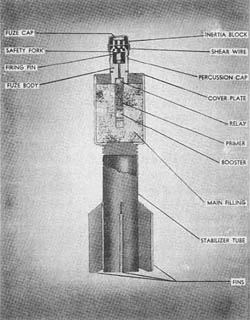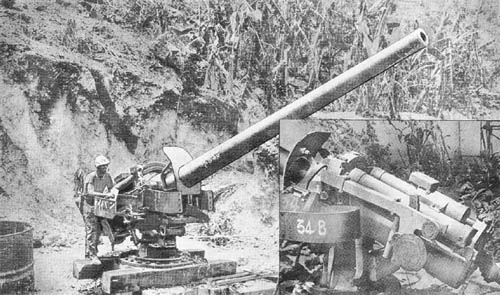 This grenade, designed to be fired from Models 38 and 99 rifles by means of a spigot launcher and wooden bullet, is similar in use and operation to the Model 91 rifle grenade. However, it is smaller and has a smooth-wall body rather than the serrated type. It contains a cyclonite primer enclosed in a brass container, a tetryl booster, and a three-ounce bursting charge of cast TNT; it is also fitted with an instantaneous fuze and a tail assembly with four fins spot welded to the rear part of the tube.
This grenade, designed to be fired from Models 38 and 99 rifles by means of a spigot launcher and wooden bullet, is similar in use and operation to the Model 91 rifle grenade. However, it is smaller and has a smooth-wall body rather than the serrated type. It contains a cyclonite primer enclosed in a brass container, a tetryl booster, and a three-ounce bursting charge of cast TNT; it is also fitted with an instantaneous fuze and a tail assembly with four fins spot welded to the rear part of the tube.
The grenade is armed by the removal of a safety fork. On impact, an inertia block is forced into the fuze body shearing a brass shear wire and driving the firing pin into the detonator.
SPECIFICATIONS
| Diameter of grenade body | 1.63 ins. | |
| Length of grenade body | 2.43 ins. | |
| Wall thickness | 1/8 in. | |
| Overall length of grenade | 7.88 ins. | |
| Weight of grenade without explosive | 14 ozs. | |
| Weight of explosive body without explosive | 10 ozs. | |
| Length of fin assembly | 4 15/16 ins. | |
| Outside diameter of tube | 1 13/16 ins. | |
| Inside diameter of tube | 1 1/16 ins. | |
| Width of tail assembly | 2 1/8 ins. | |
| Length of tail fin | 2 3/8 ins. | |
| Width of tail fin | 1/4 in. | |
| Material of construction | Steel | |
| Weight of main charge | 3 ozs. | |
| Weight of primer | 3 gr. | |
| Weight of booster | 1 gr. |
Japanese: p. 304.2 (April 1, 1945)
